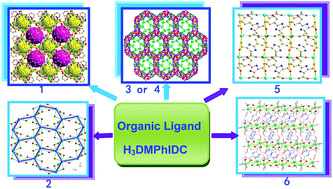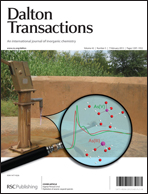Six metal–organic frameworks, namely, [Cd(μ2-HDMPhIDC)(Py)]n (H3DMPhIDC = 2-(3,4-dimethylphenyl)-1H-imidazole-4,5-dicarboxylic acid, Py = pyridine) (1), [Sr(μ2-HDMPhIDC)(H2O)]n (2), {[M13(μ3-DMPhIDC)2(H2O)6]·2H2O}n (M1 = Zn (3), or Mn (4)), [M2(μ2-HDMPhIDC)(H2O)2]n (M2 = Mg (5), or Ca (6)), have been hydro(solvo)thermally synthesized and structurally characterized by single-crystal X-ray diffraction, elemental analyses, X-ray powder diffraction (XRPD), thermal analyses and IR spectra. 1 is a meso-compound and displays a 3D non-interpenetrated framework with 1D open channels and [Cd2(HDMPhIDC)3(Py)2]4 cages, which are composed of left- and right-handed helices pillared by Cd2+ linkages. Polymer 2 exhibits a sheet structure containing infinite distorted hexagonal rings assembled from adjacent corrugated-shaped polymeric chains. Polymers 3 and 4 are isomorphous with an interesting 3D network containing infinite 1D-hexagonal channels and [M22(DMPhIDC)]6 cages, which have two interpenetrating net topologies. Both polymers 5 and 6 present interesting two-dimensional architectures. In these MOFs, the imidazole dicarboxylate ligand shows the diversity in its coordination modes and strong coordination ability. There exists antiferromagnetic coupling between the Mn(II) ions in 4. Furthermore, the solid-state luminescent properties for polymers 1–3, 5 and 6 have also been discussed in detail.


 Please wait while we load your content...
Please wait while we load your content...